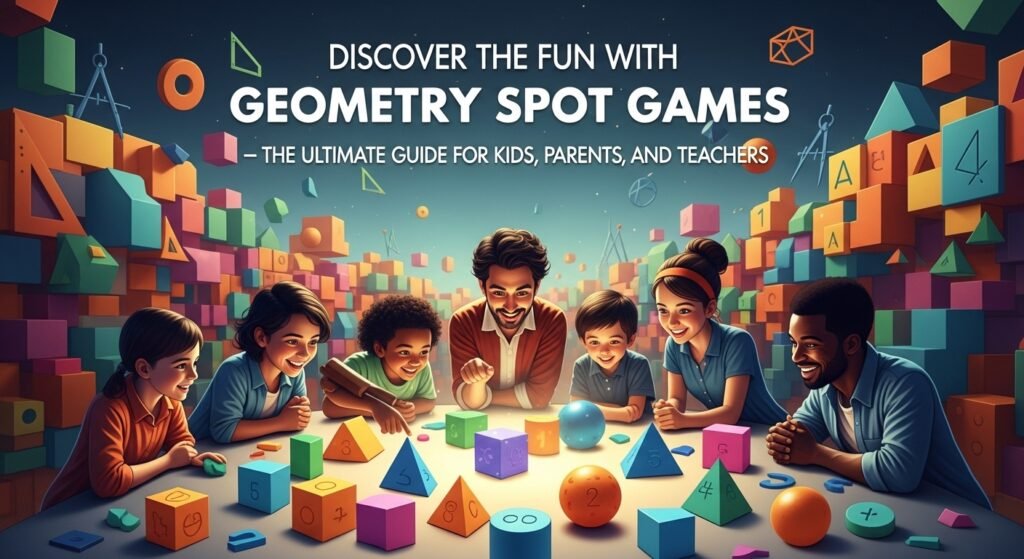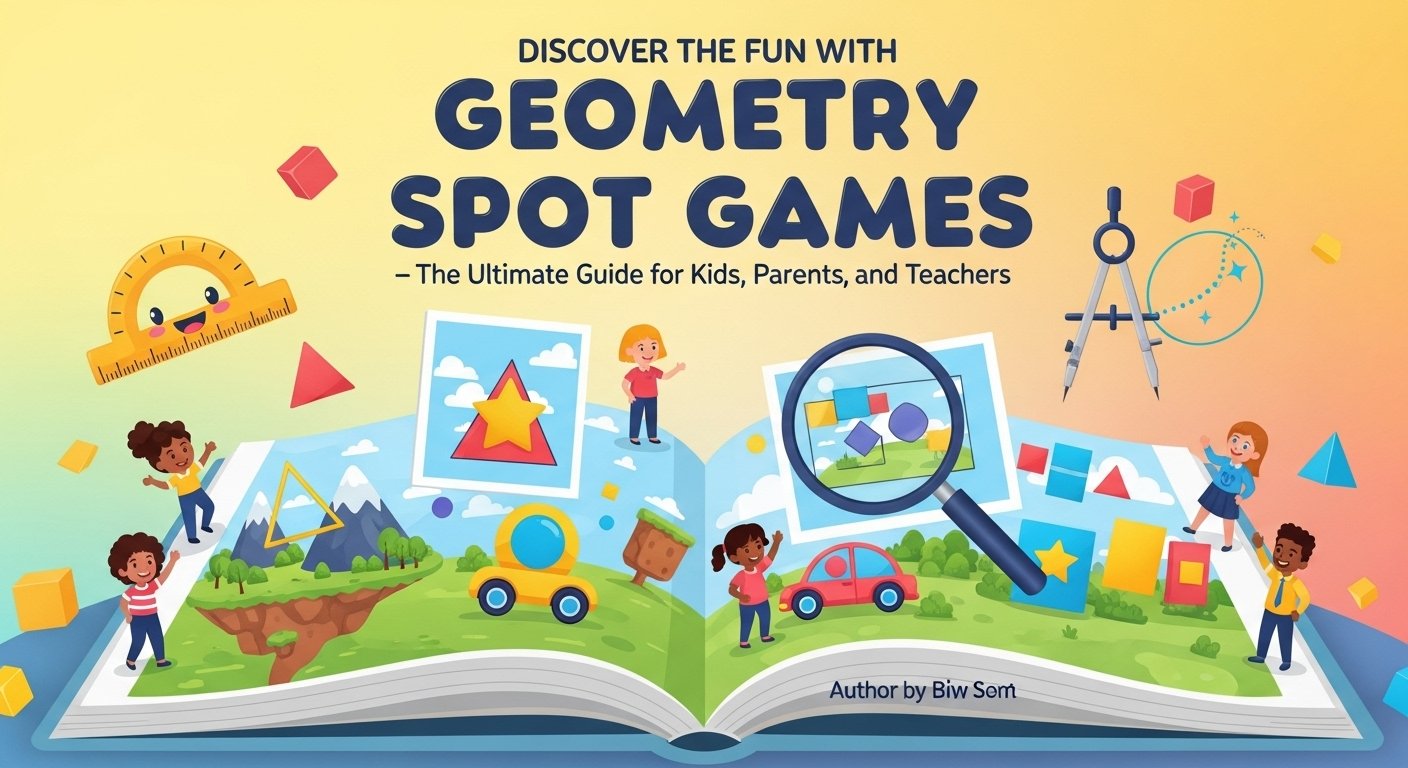Introduction
Geometry doesn’t have to be boring. In fact, it can be a whole lot of fun! If you’re someone who enjoys learning through play, then you’re going to love geometry spot games. These are online or offline games that use shapes, angles, and patterns to teach important math skills. They take tricky topics like symmetry, polygons, or coordinates and turn them into exciting activities anyone can enjoy. Whether you’re a student trying to boost your grades, a parent looking for fun learning tools, or a teacher searching for engaging classroom content—geometry spot games are a fantastic choice. This guide will walk you through everything you need to know about these games, including where to find them, how they help, and which ones are the most fun. Ready to explore geometry in a whole new way? Let’s dive in!
What Makes Geometry Spot Games Special?
Geometry spot games mix education and entertainment, which is the perfect combo for learning. These games cover topics like shapes, angles, area, perimeter, volume, and more. But instead of reading from a textbook, you get to solve puzzles, beat levels, or complete tiny challenges. That’s what makes these games special—they make learning active, not passive. You click, drag, stack, rotate, measure, and draw. And while you’re playing, you’re also thinking critically, solving problems, and improving your geometry knowledge. Many of these games also include fun characters, colorful animations, and sounds that make learning way more enjoyable. Whether you’re a beginner or already good at geometry, these games help you grow.
Learning Through Play: Why It Works So Well
One of the coolest things about geometry spot games is that they’re built for learning without pressure. Playing helps the brain stay relaxed and open to understanding new concepts. When you’re enjoying yourself, you’re more likely to remember what you’re doing. That’s why students often learn faster through games than through regular lessons. For example, a fifth-grader might struggle to understand angles in class, but when using shapes to build a virtual city in a game, it becomes easier to get. These games also let you make mistakes and try again until you understand—without feeling embarrassed. So if your math homework feels too hard, a game might be the fun, helpful break you need.
Top Geometry Spot Games to Try Right Now
Looking for the best geometry spot games to play? Here are some great ones to start with. “Shape Fit” lets you move and rotate shapes to make them fit into puzzles. “Angle Alien” involves measuring angles to guide a friendly alien back to his spaceship. “Polygon Pile-Up” asks you to stack shapes by type—like triangles, squares, and hexagons—before the timer runs out. “Coordinate Grid Challenge” teaches students how to graph and locate points on a plane while collecting treasures. Many of these games are free to play and can be found on educational websites or learning platforms like Math Playground, Cool Math Games, and Geometry Spot itself. Each game targets a specific skill, so you can enjoy learning one small bit at a time.
Where Can You Find Geometry Spot Games?
Want to play geometry spot games but don’t know where to start? Good news—there are tons of websites that offer them. One of the first places to look is the Geometry Spot website. It’s a hub for math lovers, and it offers free games, quizzes, and visual tools. Other great websites include MathPlayground.com, CoolMathGames.com, FunBrain.com, and ABCya.com. These platforms offer both single-player and classroom-friendly activities. You can play using a computer, tablet, or even a mobile phone. Some schools also give students logins for platforms like Prodigy or Khan Academy, which include interactive geometry games, lessons, and rewards systems. Whether at home or at school, you’re never too far away from your next fun geometry game.
How Geometry Spot Games Help Build Math Skills

Geometry spot games help build real math skills in a fun and easy way. When students play these games, they practice math without even realizing it. By solving in-game puzzles, they strengthen important math topics like area, volume, symmetry, shapes, and angles. These games also improve hand-eye coordination and thinking speed. Many geometry games are time-based, encouraging quick problem-solving—just like a real test, but with less stress. Some games even include real-world examples like city planning, building design, or even sports fields to show how geometry is used in life. All of this helps kids feel more confident during class and when taking tests. Playing today makes learning tomorrow easier.
Geometry Spot Games for the Classroom
Teachers can use geometry spot games to bring lessons to life in the classroom. Instead of reviewing with worksheets, try ending your geometry lessons with a game session. Kids stay more focused when they know something fun is coming up. These games can be used for group challenges, review day fun, or even as digital homework. A teacher can display the game on a smartboard and let the whole class solve puzzles together. It builds teamwork and keeps everyone engaged. Plus, many of the games track progress, so teachers can see which students are getting it and who might need help. It’s learning that feels more like recess than a math test.
Geometry Games That Don’t Require the Internet
No internet? No problem. Not all geometry spot games are online—some are offline, hands-on activities that are just as fun. Games like tangrams, pattern blocks, or shape-sorting cards are excellent geometry activities. You can also play paper-based games like “Find That Angle,” where students use protractors to measure angles hidden around the room. Board games such as “Blokus,” “Pattern Play,” or “Shape By Shape” help build geometry skills too. Teachers and parents can print out geometry worksheets or puzzles to play with at home. Offline games are great for screen breaks, road trips, or anytime you want to unplug but still learn.
Tips for Making Geometry Spot Games More Fun
To get even more out of geometry spot games, here are some tips. First, set a small goal for each play session. For example, aim to beat a level using fewer moves or faster time. Second, turn it into a friendly competition. Challenge your classmates or siblings to see who can score highest. Third, mix play with learning—try writing down the shapes and angles you find in each game. This helps connect what you see on screen to what you learn in school. Fourth, take turns playing and watching. It’s fun to cheer others on while they play and talk about why certain moves work better than others. These small tricks make learning more social, exciting, and rewarding.
Are These Games Good for All Ages?
Yes! Geometry spot games are perfect for all age groups. For younger kids, there are shape-sorting games and puzzles that teach basic geometry skills. Older students can play more complex games that involve measuring angles, plotting points, and calculating area and volume. Even adults can join the fun with logic-based shape puzzles or brain games that require problem-solving. These games can grow with you. Starting in elementary school and playing through high school keeps your geometry brain active and sharp. Some games offer different levels, so you can increase difficulty as you get better. There’s something for everyone—from preschoolers to parents.
Using Geometry Spot Games at Home
Parents can easily add geometry spot games to their child’s learning at home. All it takes is setting aside 15–30 minutes a day to play educational games instead of scrolling through random YouTube videos. Bonus tip: Play the games with your kids. It becomes a fun bonding time and shows them that learning is a lifelong adventure. You can even print out puzzles for quiet time or use a tablet during car rides. Games at home can also reinforce what’s being taught at school. When your child enjoys the topic outside the classroom, it boosts confidence and excitement during lessons. Home is the perfect place for playful math practice.
What Parents and Teachers Say About Geometry Spot Games
Many parents and teachers say geometry spot games have helped students feel more confident in math. Parents like that the games are educational and safe. Many of these websites offer ad-free or child-friendly play environments, which makes them feel more comfortable letting kids play solo. Teachers say these games are wonderful for review or extra practice. One teacher shared how a usually shy student became the “Geometry Game King” in class after being the first to solve a tricky puzzle. These fun moments create a positive math mindset. Sometimes all it takes is one great game to make a child believe, “Hey, I’m actually good at this!”
FAQs
Q1: Are geometry spot games free to play?
Yes, most geometry spot games are free and can be played without signing up. Some do offer upgrades or paid versions.
Q2: Do I need a fast computer to play these games?
Not at all. Most games work on regular computers or tablets and don’t need high-tech gear.
Q3: Are these games safe for kids?
Yes, popular education websites provide child-safe games without harmful ads or links. Always check the site first.
Q4: Can geometry spot games improve test scores?
They can help! These games boost confidence, sharpen skills, and offer extra practice in a fun way.
Q5: Are there multiplayer geometry games?
Yes, some sites offer team challenges or quizzes where friends can compete together or against each other.
Q6: Do these games follow school curriculums?
Many do. They’re designed by educators and often match Common Core or school standards for each grade level.
Conclusion
If you ever thought math was boring, geometry spot games are here to change your mind. These fun, smart, and exciting games bring shapes, angles, and measurements to life. Whether you’re playing at home, in school, or with friends, you’re learning important skills without even realizing it. From boosting test scores to building confidence, these games do more than entertain—they teach. Best of all, they make learning feel like play. So the next time you want to learn math and have fun at the same time, open up a geometry game and start exploring. You’ll be amazed at how much you enjoy it!






